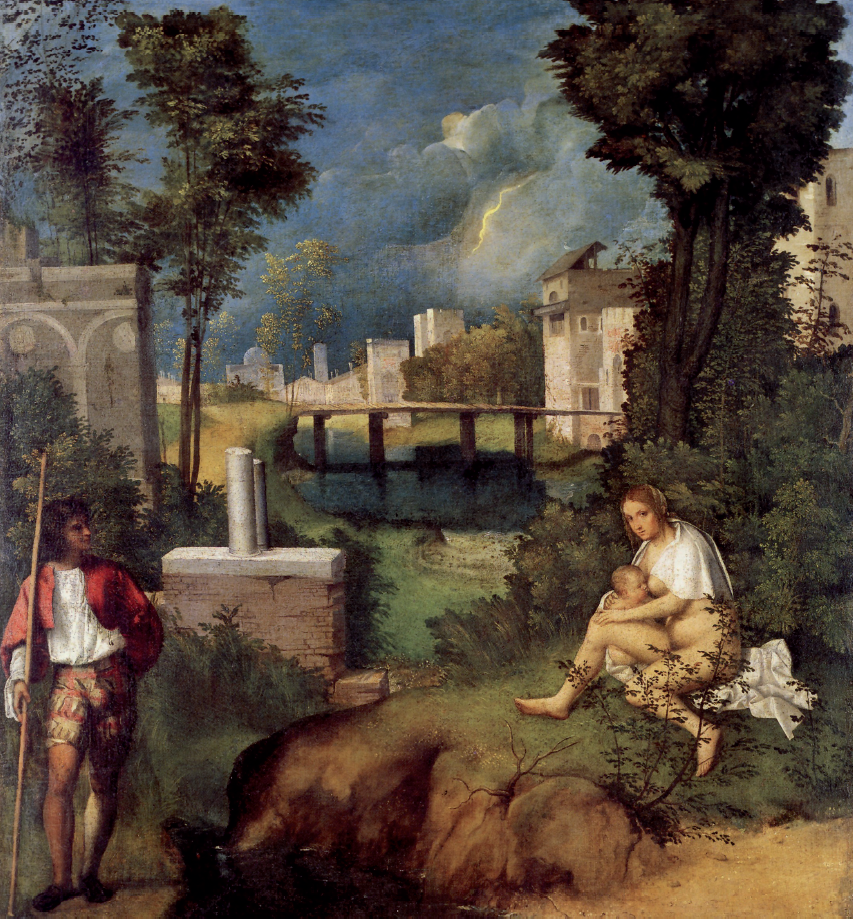We all know it: the famous Tempest painted by Giorgione in the early sixteenth century, a canvas whose success, at least in our time, is partly due to the search for arcane symbolism, sometimes quite abstruse, behind its surface of rural scene threatened by an impending downpour.
The suspended, veiled, timeless atmosphere, the silence of a nature obfuscated by the storm broken only by thunder in the distance and that woman who looks at us vaguely wrinkled while the soldier looks at you intent on breastfeeding. In the background, a city that is not well defined and in the background, behind the soldier, are ruins that are also motionless and silent.

The list of those who have attempted an interpretation is long and today I would like to speak in favour of a minority vision but in my opinion with a good chance of approaching the truth, the one for which the Tempest would not hide anything and this because of two elements that made me thoughtful.
Marcantonio Michiel (1484-1552) was a young man from a patrician family (at least for his father’s side) with little political-administrative attitude but with a first-class philological culture combined with a passion and instinct for art that made him one of the greatest, if not the greatest, connoisseur of the time and an important node in a network of intellectuals that included figures of the calibre of Serlio, Bembo, Aretino, Giovio. The greatest merit of Michiel, however, at least for us, is to have left us an impressive amount of notes on the works observed in the noble houses he used to frequent, notes that should have come out of the state of drafts to become a more organic work that unfortunately never saw the light seems also because of the release, in the meantime, the first edition of Vite by Giorgio Vasari (1550) of which Michiel did not want to create a sort of duplication. These notes, whose autographs are kept at the Marciana Library in Venice, were only published in 1800 under the title of “Notizia d’opere di disegno nella prima metà del secolo XVI” (News of drawing works in the first half of the 16th century) and were fundamental for tracing and dating many works of the venetian Renaissance as well as integrating the corpus of various artists with works now lost.
Well, what do you write about the Tempest observed in the collection of Gabriele Vendramin (who in all probability was also the buyer)?
“El Paesetto in tela con la tempesta, con la cingana e soldato, fu de man de Zorzi da Castelfranco”1
That’s it. Now you don’t have to imagine Michiel wandering around the halls of the Vendramin house with a glass of wine in his hand during a party, distractedly looking at the canvases: these visits took place under the proud supervision of the landlord (and often with the accompaniment of other learned guests) who was the first to provide information about the work. Michiel often puts his own judgements alongside the “official” ones, and they are considered and competent judgements, and he is almost always precise in the description of the iconographies, which, in the case of the Tempest, gives one to think. It seems very strange that Vendramin wanted to hide any hidden meaning of the work from his esteemed peer review, not to mention the fact that it would not have taken Michiel long to find it on his behalf, as it seems strange, given the cultural and religious temperament of Venice in those years, definitely tending to laissez-faire, that the possible message has been kept silent in concert with the owner so as not to run into some unlikely ecclesiastical anger in the face of mildly pagan theories.
Another element is the original composition of the painting. In fact, the Tempest was not born as we see it today: several radiographic examinations have revealed that originally neither the soldier nor the newborn were present, the woman was sitting on the opposite bank of the watercourse a little lower and with her legs in the water, there was a figure passing on the bridge intent on carrying a load and above the columns a rather bulky tower. In short, the original layout was definitely different, which is not in keeping with the idea of a work destined to act as a vector for a precise mysterious-philosophical message.
These of course are not “evidences” but only food for thought, however well-founded, and as such I propose them but the suspicion that the Tempest at bottom was conceived simply as a naturalistic capriccio is quite substantial. The fact that this capriccio has matured in a cultural environment steeped in classical references takes the discourse to a more general level. The suspicion is also supported by the fact that in the early sixteenth century in Venice were well known and appreciated the works of the young Nordic school (Durer, Cranach, Altdorfer) that had overwhelmingly introduced the theme of nature and landscape to a much greater extent than was in use until then and established in the years immediately before a more than fruitful relationship with the Venetian, hybridizing and being hybridized in turn in one of the most virtuous circles in the history of art.